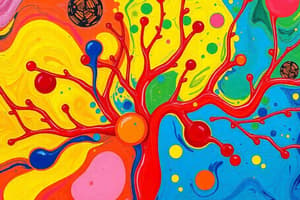Podcast
Questions and Answers
What are the functions of saliva?
What are the functions of saliva?
Saliva lubricates and protects oral tissues, aids in control of microbial flora in the oral cavity, and starts the digestion of complex carbohydrates by secreting α-amylase.
What are the three major salivary glands?
What are the three major salivary glands?
The three major salivary glands are the parotid gland, submandibular gland, and sublingual gland.
What is the ductal system of the salivary glands?
What is the ductal system of the salivary glands?
The ductal system of the salivary glands includes intercalated ducts, striated ducts, and interlobular ducts.
What are the three components of the portal triad?
What are the three components of the portal triad?
What are the three layers of the gallbladder wall?
What are the three layers of the gallbladder wall?
What is the function of the gallbladder?
What is the function of the gallbladder?
What is the composition of the lining of the gallbladder mucosa?
What is the composition of the lining of the gallbladder mucosa?
What are the functions of the pancreas?
What are the functions of the pancreas?
How is the parotid gland structured?
How is the parotid gland structured?
What are the characteristics of the submandibular and sublingual salivary glands?
What are the characteristics of the submandibular and sublingual salivary glands?
What are the functions of the liver?
What are the functions of the liver?
Study Notes
Saliva and Salivary Glands
- Saliva performs various functions, including lubrication, buffering, and digestion
- Three major salivary glands: parotid, submandibular, and sublingual
- Ductal system of salivary glands: responsible for transporting saliva from glands to oral cavity
Liver and Gallbladder
- Portal triad components: hepatic artery, portal vein, and bile duct
- Gallbladder wall layers: mucosa, muscularis, and serosa
- Gallbladder function: stores and concentrates bile produced by the liver
- Gallbladder lining (mucosa) composition: simple columnar epithelium with microvilli
Pancreas
- Pancreas functions: exocrine (produces digestive enzymes) and endocrine (produces hormones like insulin and glucagon)
Salivary Glands Structure and Characteristics
- Parotid gland structure: serous gland with a duct system that opens opposite the upper second molar
- Submandibular and sublingual glands: mixed glands with serous and mucous acini, and ducts that open in the oral cavity
Liver Functions
- Liver functions: detoxification, metabolism, storage, and production of proteins and nutrients
Studying That Suits You
Use AI to generate personalized quizzes and flashcards to suit your learning preferences.
Related Documents
Description
Test your knowledge on the accessory organs of the gastrointestinal tract with this quiz. Learn about the gross anatomy and histology of the salivary glands and pancreas.




